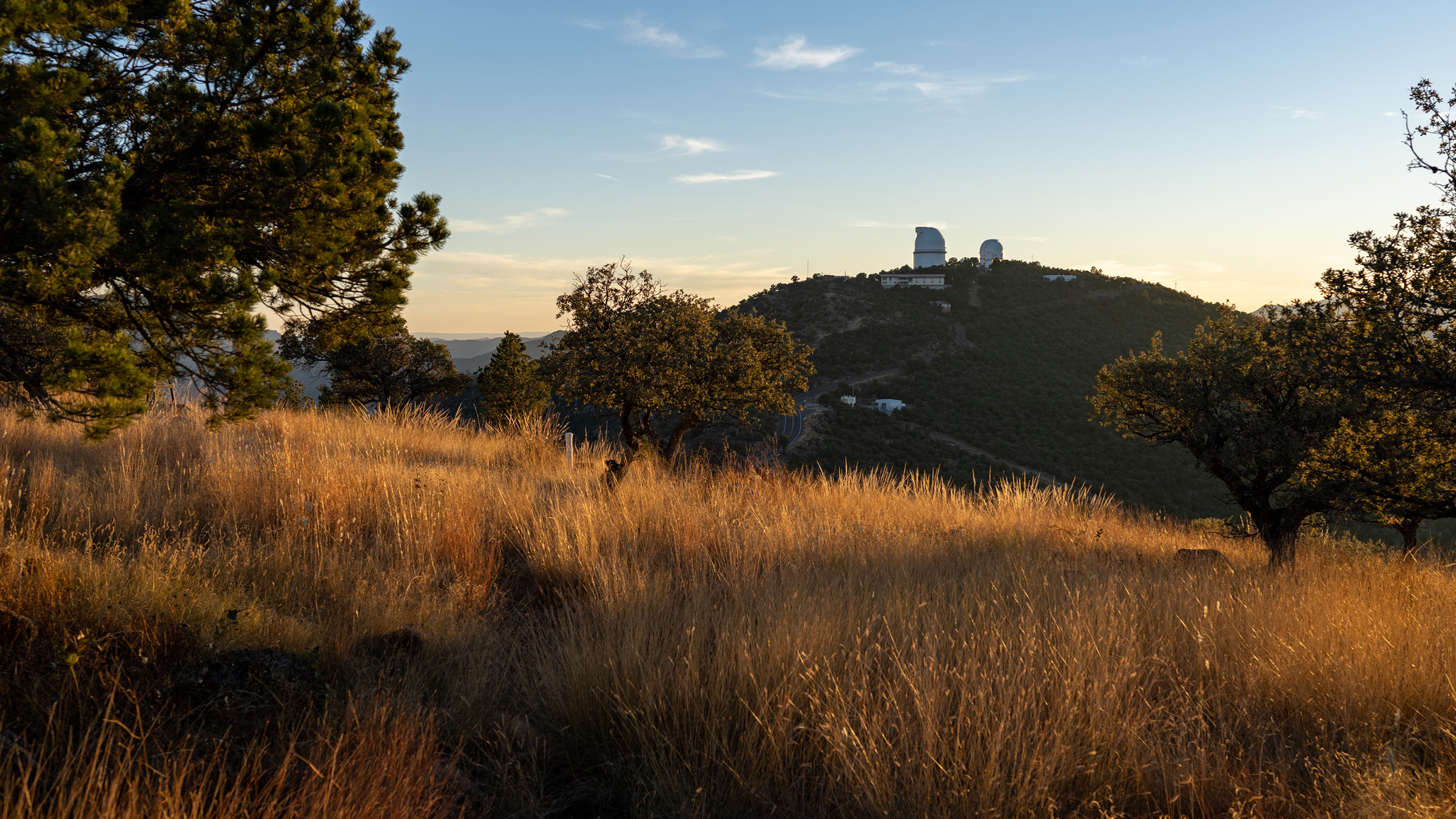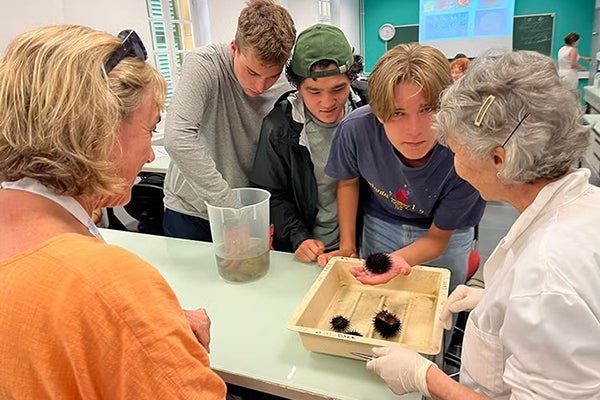Texas Field Station Network Catalyzes Collaborations Across Field Sites
The recently announced largest-ever gift to the college is helping to bring new research synergies.

McDonald Observatory. Credit: Nolan Zunk.
Astronomers at UT’s McDonald Observatory were getting nervous. In 2011, the Rock House Fire had burned more than 300,000 acres right at the observatory’s doorstep, threatening hundreds of millions of dollars’ worth of telescopes and scientific equipment. Two years later, a huge firestorm barely missed destroying the telescopes at Australia’s largest optical astronomy facility. In 2017, wildfires in California and Arizona nearly took out Mount Wilson Observatory and Mount Graham International Observatory.
McDonald Observatory administrators reached out to UT’s Fire Prevention Services, who put them in touch with Matthew O’Toole at the Lady Bird Johnson Wildflower Center. He’d had years of experience managing prescribed burns to support the conservation of fire-adapted native plants and protect the center from wildfires. What emerged was an inter-agency crafted campus wildfire protection plan (CWPP) that enlisted Texas A&M University’s Forest Service to manually thin trees and other fuel near the observatory’s facilities, diversify plant species, upgrade water infrastructure for dousing fires and more. Everyone at the university’s westernmost outpost is breathing a little easier now.
“Not every field station site has the capacity to manage everything to the degree and expertise that it should be done,” O’Toole says. “And I think the beauty of this network is that we have expertise at different things in different places across our various sites.”
Now the observatory is returning the favor. Stephen Hummel, McDonald’s dark skies coordinator, is advising the Wildflower Center on how to reduce light pollution at its site. It was thanks to the new Texas Field Station Network that he was in the right room with the right people at the Wildflower Center to make the connection.

Staff at the Lady Bird Johnson Wildflower Center in Austin have extensive experience with fire management. Photo credit: Nolan Zunk.
The Network Effect
Announced earlier this academic year as a major gift made possible by Winn Family Foundation, the Texas Field Station Network brings the university’s various field stations—five in Central Texas (the Wildflower Center, the Brackenridge Field Lab, Stengl Lost Pines Biological Station, the White Family Outdoor Learning Center and a planned Hill Country Field Station), one on the Gulf Coast (Marine Science Institute) and one in West Texas (McDonald)—under one umbrella to share expertise and open up new collaborations.
“UT is a big system, and we’ve got a lot of resources on hand and a lot we can learn from each other,” Hummel says. “Rather than reinvent the wheel and do it all ourselves, I think it’s just more efficient to work together.”
Long an interest of astronomers, the goal of restoring dark skies in our increasingly glowing nighttime world is now sparking interest among biologists who are recognizing the disorienting impact of light on plants and animals.
As the Wildflower Center prepares to put a new lighting plan in place in the coming years, there’s also an opportunity to educate the hundreds of thousands of annual visitors at this suburban field station to the benefits of dark skies.
“The Wildflower Center is ideally situated to be a voice for dark skies and conservation, particularly in an urban environment where the need is more acute and where it will reach a bigger audience,” Hummel says. “So that was our rationale for reaching out to them.”
Shalene Jha, a professor of integrative biology at the University of Texas College of Natural Sciences and director of academic research at the Wildflower Center, is already thinking about how to conduct research on light’s impact on the ecosystem. Some insects, called crepuscular foragers, are especially sensitive to light around dawn and dusk. When light pollution is reduced, will these insects have a positive boost? Will plants that respire at night have more breathing room? Decades of baseline data at the center will help compare the ecosystem before and after the changes.
“We’re entering this new era where the Wildflower Center sees itself as a member of the Texas Field Station Network, and I think that is really positive,” Jha says. “Now it’s not standing alone. It can benefit from the expertise of these other field stations. And who could be better than McDonald to advise on goals related to reducing light pollution?”
Better Together
The potential exchange of expertise and inspiration across the Texas Field Station Network is practically limitless.
For example, outreach efforts at the Marine Science Institute (MSI)—UT’s outpost on the Texas Gulf Coast—are motivating staff at the Wildflower Center to make their outreach exhibits and programs more engaging. On a recent visit, Wildflower Center staff were inspired by the interactive exhibits, such as touch screens with short video profiles of MSI scientists and students and touch tanks allowing visitors to feel the bumpy, slimy, spiky denizens of the local waterways.
Meanwhile, the Wildflower Center’s O’Toole is currently working with MSI on a restoration plan at a site called St. John’s Prairie near Refugio, Texas, involving prescribed burns and mechanical thinning, to help restore a coastal tallgrass prairie.
Jha notes that a network of field stations can enable single projects to span multiple sites, covering a much wider geographic area. For example, Jha has used a range of field sites over a large area to study bumblebees and how the kinds of foraging options available to them affects their diet. She found that when they have few foraging options, they’re less picky.
“But if they have more options, you can really see what their preferences are,” she says. For this kind of research, she needed sites that vary in the breadth of options available to bumblebees in order to figure out how the bees are making decisions.
Jha also points to a long-term research project on drought that uses three sites in the Texas Field Station Network—the Wildflower Center, Stengl Lost Pines and Brackenridge Field Lab (BFL). UT ecologists, including assistant professor of integrative biology Amy Wolf and BFL station manager Jason Lawson, are simulating droughts in small plots by blocking half of all rainfall from reaching the ground. It’s part of an international project called DroughtNet involving more than 100 field sites on six continents. By partnering with a much larger network of field sites, the research covers a global footprint.
“Networks like these provide a framework,” Lawson has said, “for how to implement meaningful large-scale and long-term studies across Texas to improve our understanding of the ecology of Texas and the impacts we’re having on our native environment.”



